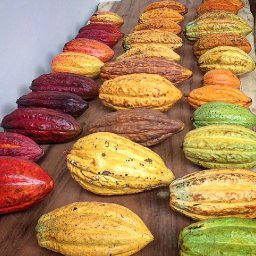Hi Everybody,Brad Churchill here from Choklat (
www.SoChoklat.com ).I've spent the last little while reading the various exchanges with regard to the topic of "re-melters", and would like to add my own 2 cents for what it's worth.4 years ago I began researching how to make my own chocolate, because as a consumer I learned that all of the chocolatiers I purchased from locally here in Calgary, bought bulk chocolate, melted it down, wrapped their name around it and called it "their chocolate". Personally, I felt lied to, and vowed never to purchase another chocolatier's confections again.At some point my recreation, transformed into business analysis, and in August of last year I opened "Choklat" - the first company in Western Canada that makes chocolate from bean to bar.Here in Calgary, the prolific chocolatier/measuring stick is Chocolaterie Bernard Callebaut - grandson of the founder of the Belgian Callebaut Chocolate factory. EVERY DAY for the first 6 months we were open I was asked what made our chocolate better than that which Bernard Callebaut makes. EVERY DAY for the first 6 months I had to explain that Chocolaterie Bernard Callebaut DOES NOT make chocolate. Some people were offended that I would speak such blasphemy about a local icon - at least until I produced the letter his lawyer sent us, threatening court action against me because I was "making him look bad." Yet, as a business person, I was simply differentiating my product from his, and telling the truth!I publicly stated that Mr. Callebaut bought his chocolate from one of the largest factories in the world. His lawyer wrote that he actually purchased his chocolate from THREE sources. It was all I needed!For over 20 years, he has led almost all Calgarians to believe he made the chocolate he used in his confections.I didn't back down. In fact after I sent him a PFO letter, I continued "educating" the public, and as a result have been receiving many accolades of my honesty and refreshing approach to the industry. People LIKE the truth, and the fact that I've had over 2.5 million hits to my website, and business is growing exponentially is testament to that statement.As far as I'm concerned, if you are a chocolatier and use someone else's couverture to make your product, that's fine. Be proud of it, and let people know you're proud to use a specific maker's chocolate.However, if you tell people you make chocolate, and there's no roasters, winnowers, or refiners which you have control over in your process, you better be prepared to be called a liar, and I'll be the first to stand up and point the finger.As a true "maker" and chocolatier, I can understand another maker's frustration in trying to differentiate their product from the rest of the marketplace. It's tough. Public perception has been skewed for many years.In the end though, what really matters is how the product tastes to your customer. If they like it better than the next chocolatier's they'll buy it regardless of whether or not you make it from the bean. By controlling 100% of the process, the maker has an edge in being able to make a better quality chocolate than that which every other chocolatier is only able to purchase.That's my two bits for what it's worth.




